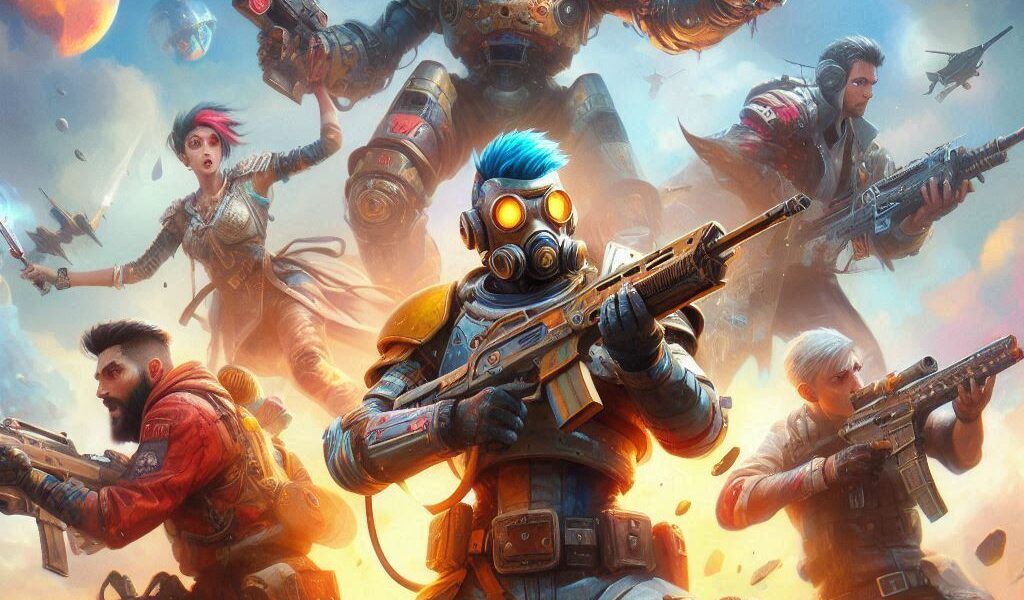Action games have been a staple of the video game industry since its inception, captivating players with fast-paced gameplay, thrilling combat, and engaging challenges. From the pixelated worlds of early arcade classics to the visually stunning, immersive experiences of modern hits, action games have evolved significantly over the decades. This comprehensive guide explores the journey of action games, highlighting iconic titles, key innovations, and the enduring appeal that keeps players coming back for more.

Part 1: The Golden Age of Action Games
Early Beginnings and Arcade Classics
Action games began to take shape in the late 1970s and early 1980s with the rise of arcade gaming. These early games, defined by simple mechanics and intense, adrenaline-fueled gameplay, laid the foundation for the action genre.
- Space Invaders (1978): Often credited as one of the first action games, Space Invaders revolutionized arcade gaming with its easy-to-learn, difficult-to-master gameplay. Players controlled a laser cannon, shooting waves of descending alien invaders. The game’s escalating difficulty and high-score system made it a hit and set the standard for action games that followed.
- Pac-Man (1980): Though not a traditional action game in the sense of combat, Pac-Man introduced elements of quick reflexes and strategy. As players guided the yellow character through mazes, evading ghosts and collecting pellets, it combined fast-paced gameplay with increasing tension.
- Donkey Kong (1981): This title marked the debut of both the action-platformer genre and the iconic character Mario (then known as Jumpman). Players had to navigate treacherous levels filled with barrels, fireballs, and other hazards to rescue the damsel in distress, showcasing early action game storytelling.
The Rise of the Action Platformer
As home consoles became more popular in the mid-1980s, the action-platformer genre flourished, allowing players to experience the excitement of arcade games from the comfort of their homes.
- Super Mario Bros. (1985): Considered one of the most influential action games of all time, Super Mario Bros. defined the platforming genre. The game’s tight controls, varied levels, and innovative power-ups helped create a formula that many action-platformers would follow. Its blend of exploration, combat, and puzzle-solving remains a hallmark of the genre.
- Metroid (1986): Metroid introduced players to an expansive, interconnected world filled with exploration and combat. It combined platforming with shooting elements, giving rise to the “Metroidvania” subgenre. The game’s open-ended design and hidden upgrades made it a standout in the action-adventure space.
- The Legend of Zelda (1986): While more closely associated with adventure games, The Legend of Zelda incorporated significant action elements. Its real-time combat, exploration of vast environments, and intricate puzzles laid the groundwork for future action-adventure titles.
Part 2: The Evolution of Action Games in the 1990s
The Birth of 3D Action Games
The 1990s marked a pivotal shift in the action genre, as advancements in hardware allowed for the transition from 2D to 3D graphics. This era saw the birth of iconic franchises that would redefine what action games could be.
- Super Mario 64 (1996): As one of the first successful 3D platformers, Super Mario 64 revolutionized the action genre with its fully realized 3D world, tight controls, and non-linear level design. Players could explore large, open environments, collecting stars and battling enemies in real-time. The game’s innovative camera system also set a new standard for how players navigated 3D spaces.
- Tomb Raider (1996): Tomb Raider introduced players to Lara Croft, an adventurer who could run, jump, and climb through complex 3D environments. The game blended puzzle-solving with third-person action, and its cinematic presentation helped elevate action games to new heights.
- GoldenEye 007 (1997): This first-person shooter, based on the James Bond film, introduced multiplayer deathmatches, a mode that would become a staple in many future action games. GoldenEye 007 combined stealth, combat, and exploration, making it a landmark title for both first-person shooters and action games.
The Emergence of Fighting and Beat ‘Em Up Games
The 1990s also saw the rise of fighting games and beat ’em ups, genres that focused heavily on combat and player-versus-player competition.
- Street Fighter II (1991): Street Fighter II is widely regarded as one of the most influential fighting games of all time. Its deep mechanics, balanced roster of characters, and competitive gameplay set the standard for the genre. The introduction of special moves and combos revolutionized how players approached combat in action games.
- Mortal Kombat (1992): Known for its violent gameplay and iconic “fatalities,” Mortal Kombat pushed the boundaries of what action games could depict. It became a cultural phenomenon and sparked debates about video game violence, leading to the creation of the Entertainment Software Rating Board (ESRB).
- Streets of Rage (1991): The Streets of Rage series exemplified the beat ’em up genre, offering cooperative gameplay where players fought waves of enemies in side-scrolling levels. Its emphasis on cooperative play and satisfying combat mechanics made it a standout title in the early 90s.
Part 3: Modern Action Games
The Open-World Revolution
As gaming technology continued to improve, action games expanded into vast open-world environments, giving players unprecedented freedom to explore and interact with their surroundings.
- Grand Theft Auto III (2001): Grand Theft Auto III revolutionized action games by introducing a fully open world where players could complete missions, engage in combat, and explore at their own pace. Its combination of narrative-driven gameplay and open-ended exploration became the blueprint for many modern action games.
- Assassin’s Creed (2007): Assassin’s Creed blended historical settings with parkour-based traversal and stealth action. Players could explore massive cities, climb buildings, and engage in combat with a unique blend of swordplay and acrobatics. The series’ focus on open-world exploration and fluid movement mechanics set it apart from other action games of the time.
- The Witcher 3: Wild Hunt (2015): The Witcher 3 took open-world action to new heights with its richly detailed world, deep narrative, and complex combat system. The game’s emphasis on player choice and the consequences of their actions made it a standout title in the action-RPG genre.
Innovations in Combat Systems
Modern action games have continued to refine and innovate their combat systems, providing players with increasingly fluid and dynamic ways to engage with enemies.
- Batman: Arkham Asylum (2009): Batman: Arkham Asylum introduced a revolutionary free-flow combat system that allowed players to seamlessly chain together attacks, counters, and gadgets in fluid, cinematic battles. This system has been widely adopted by other action games, particularly those focused on melee combat.
- Dark Souls (2011): Dark Souls redefined the action genre with its punishing difficulty, methodical combat, and intricate level design. Its emphasis on timing, stamina management, and tactical combat influenced a new subgenre known as “Souls-like” games, which prioritize challenge and mastery.
- God of War (2018): The 2018 reboot of God of War introduced a more intimate, grounded combat system compared to its predecessors. Players could switch between melee attacks and ranged abilities while managing a more personal, emotionally-driven story. The game’s combat design and narrative depth pushed the boundaries of what action games could achieve.
Part 4: The Future of Action Games
Virtual Reality and Immersive Experiences
The future of action games is closely tied to advancements in virtual reality (VR) and other immersive technologies.
- Half-Life: Alyx (2020): Half-Life: Alyx demonstrated the potential of VR in the action genre. Players could interact with the environment in new ways, using their hands to pick up objects, reload weapons, and solve puzzles. The game’s immersive world and innovative use of VR mechanics set a new benchmark for action games in the virtual space.
- VR Combat Games: Titles like Blade and Sorcery and Superhot VR offer intense, physical combat experiences where players must use their body movements to attack, dodge, and strategize in real-time. As VR technology continues to evolve, these types of action games are likely to become more sophisticated and widely adopted.
AI-Driven Combat and Dynamic Worlds
Artificial intelligence (AI) and machine learning are playing an increasingly important role in action game development, allowing for more dynamic, responsive, and intelligent enemies.
- Procedural Content Generation: AI-driven procedural content generation allows games to create unique, unpredictable environments and encounters. This technology can provide endless replayability and ensure that each player’s experience is different from the last.
- Adaptive AI Opponents: Future action games will likely feature enemies that adapt to player strategies in real-time. These intelligent opponents can learn from player behavior, offering a more challenging and engaging experience.
Expanding Multiplayer and Co-op Action
Multiplayer and cooperative action games are becoming increasingly popular, allowing players to team up and experience action-packed gameplay together.
- Destiny 2 (2017): Destiny 2 offers a blend of first-person shooting and MMO-style gameplay, where players can team up with others to complete missions, engage in PvP (player versus player) combat, and explore vast, dynamic worlds.
- Cooperative Action Games: Titles like Monster Hunter: World and Warframe allow players to collaborate in tackling challenging enemies and missions. These games emphasize teamwork, strategy, and communication, providing rich cooperative experiences that are likely to become more prominent in the future.
Conclusion
From the arcade classics of the 1980s to the expansive open worlds of today, action games have continuously evolved, pushing the boundaries of gameplay, narrative, and technology. The genre’s ability to adapt and innovate ensures its lasting popularity, offering players thrilling experiences across a wide variety of settings and styles. As VR, AI, and multiplayer technologies continue to develop, the future of action games promises even more exciting and immersive adventures. Whether you’re revisiting old favorites or exploring the latest hits, the world of action gaming remains as exhilarating as ever.




